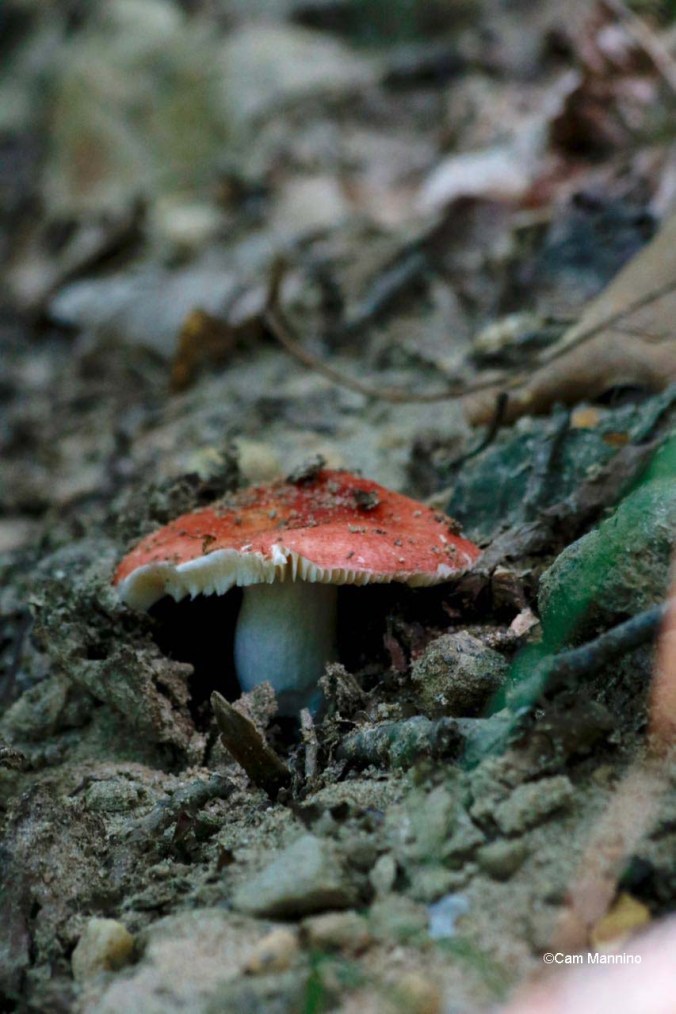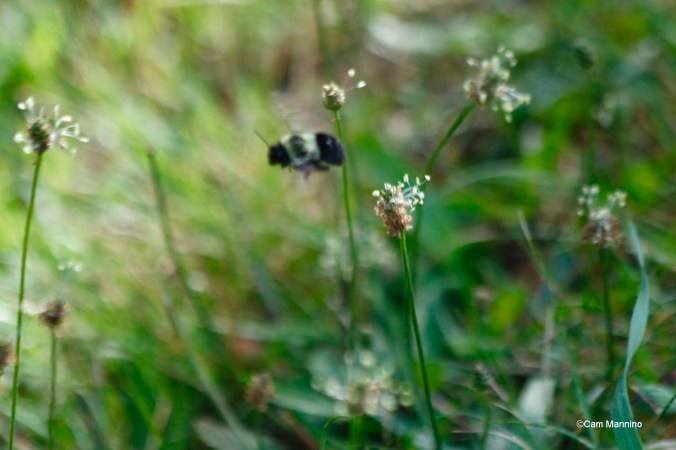The diversity of Oakland Township’s parks and natural areas is a source of repeated surprise and delight for me.
In the last few, very hot weeks, my husband Reg and I have explored the cool, shady trail that threads its way through Stony Creek Ravine Nature Park, a hidden gem that is still under development by the Parks and Recreation Commission. Be prepared to feel you are up north or even out west as you wind your way along a high ridge overlooking the creek.
The 0.4 mile hike isn’t long but it is dramatic. You begin in a tunnel formed by tall shrubs. Here Reg stops to listen to birdsong as we enter the park.
Gray Catbirds meow from the thickets, Black-capped Chickadees scold on nearby branches – and birdsong flows down from the treetops, trilled by cardinals and other songsters that I don’t yet recognize by ear.

Black-Capped Chickadees (Poecile atricapillus) search the trees for the insects and spiders that make up most of their diet at this time of year.
Occasionally the trail opens to reveal grassy areas filled with wildflowers. Ben and his summer technicians have worked hard to restore some of the open areas that once existed here.

Native plants like Bee Balm (Monarda fistulosa) again find a home here as restoration continues in the park.
By ridding areas of invasive shrubs, native wildflowers and grasses like these below find a home here once more.

White Avens (Geum canadense), a modest native wildflower, competes for the sunlight in restored areas.
In these sunny meadows, a large, native Staghorn Sumac (Rhus typhina) basks in the sunlight without competition from the invasive shrubs that Ben removed last year.
Mushrooms grow on the moist, steep sides of the ravine. This one appears to be a mushroom from the genus Amanita, mushrooms toxic to humans. Squirrels, though, eat them with no ill effect.I think a nip’s been taken out of this one, actually.
Of course, all the flowers attract the bees and butterflies who share your walk. For a few minutes, a Bumblebee (genus Bombus) seemed to be enjoying riding down thin stalks of Narrow-Leaved Plantain (Plantago lanceolata) in the middle of the trail. This small bee seemed to be working awfully hard for the limited nectar or pollen on these plants. Maybe it was just a youngster having a good time or practicing its technique?

The bumblebee repeatedly rode the stalks to the ground, busily trying to gather nectar and seemingly enjoying the ride.
Where there’s water, of course, there are damselflies. Ebony Jewelwings (Calopteryx maculata) balance on the leaves at Stony Creek Ravine and can be seen in groups down near the water.
The shy Little Wood Satyr butterfly (Megisto cymela) doesn’t search for nectar or pollen. It bustles about in low foliage looking for plant sap or the sticky honeydew left by aphids.
The trail winds gently on into the cool shade of an oak forest.
Along the trail, you’ll see the remains of a farmer’s old stone wall, evidence that this land was once more open and sunny than it is today.
The land begins to fall away on either side of the path, plunging dramatically down to Stony Creek as it winds its way through the narrow ravine below. What a view! And the grade is much steeper than a photo can even make it look!
It’s important to stay on the trail here since the stream bed is a conservation area and downhill sliding and slipping causes erosion and damage. Here are some of our native plants that find a home at the bottom of the ravine, right near the water. (Hover cursor for captions; click on photo to enlarge).
- Water Hemlock (Cicuta maculata) may have been used to execute Socrates!
- Fringed Loosestrife (Lysimachia ciliata) is a native, unlike Purple Loosestrife.
- Sensitive Fern vegetative fronds in summer do the work of photosynthesis.
White-Tailed Deer (Odocoileus virginianus) are prevalent in this park. The Parks and Recreation Commission allows controlled hunts in this park every Tuesday and Wednesday from October 1 to January 1, with a PRC-issued special license, to provide opportunity for hunters and to manage the high density of deer in the park. Since the park is closed on those days for 3 months, come visit this slice of dramatic beauty on different days or during the other 9 months of the year .

Deer hunting is allowed, with a PRC license, Tuesdays and Wednesdays from Oct.1 to Jan.1. No hiking then!
Currently the park’s trailhead is at the end of Knob Creek Drive which is off E. Gunn Road. Right now there is only room for one car to park off-road at the entrance. The PRC applied for a grant to help purchase an adjacent 209 acres to expand this park – an area full of wildflowers and the wetlands that birds and amphibians love, plus space for plenty of parking off Snell Road. Fingers crossed that we receive that grant!
The trail takes you to a great vantage point and then ends within the park’s forest of sturdy oaks and their saplings. When you turn to walk back, you’ll be surprised, I think, by how much you notice that escaped your attention on the way in. I always am.

Large Red and White Oaks stand among smaller trees along the top of the ridge at the end of the trail.
We all probably have our favorite natural areas in Oakland Township. Mine’s always been Bear Creek Nature Park and yours may be the Paint Creek Trail or Cranberry Lake Park. But it’s exciting to explore the paths “less traveled by” with fresh eyes. Beauty takes so many forms in the natural world and I love being introduced to landscapes nearby that I’ve never seen before. Give it a try. You never know. As poet Robert Frost suggested, taking one of these paths “less traveled by” may make “all the difference.”
Footnote: My sources for information are as follows: Ritland, D. B., & Brower, L. P. (1991); Stokes Nature Guides: A Guide to Bird Behavior Volumes 1-3, Allaboutbirds.org, the website of the Cornell Ornithology Lab at Cornell University; Wikipedia; http://www.butterfliesandmoths.org; Herbarium of the University of Michigan at michiganflora.net; various Michigan Field Guides by Stan Tekiela; Butterflies of Michigan Field Guide by Jaret C. Daniels; University of Wisconsin's Bug Lady at www4.uwm.edu/fieldstation/naturalhistory/bugoftheweek/ for insect info; http://www.migrationresearch.org/mbo/id/rbgr.html for migration info; invaluable wildflower identification from local expert, Maryann Whitman; experienced birder Ruth Glass, bird walk leader at Stoney Creek Metro Park for bird identification; Birds of North America Online; Audubon.org; Nature in Winter by Donald Stokes, Trees in My Forest by Bernd Heinrich, Winter World by Bernd Heinrich, Savannah River Ecology Lab (Univ of Georgia); Tortoise Trust website www.tortoisetrust.org; An Orchard Invisible: A Natural History of Seeds by Jonathan Silvertown; The Ecology of Plants by Gurevitch, Scheiner and Fox; other sites as cited in the text.
















Thanks Cam and Reg for another great post on one of our outstanding parks. Your photographs and descriptions of what is available for all to see is a tribute to the outgoing Parks Commissioners. Although you and Reg are not on the Commission, you are both major advocates for our Parks. Thanks again!
We do love parks! Just this morning we were out together at the modest Gallagher Creek Park discovering all kind of cool birds, insects, plants, etc. – and looking for a Great Horned Owl who hides in the branches of a tree there. I hope to have a piece on the surprises in that little 15 acre park soon. We’re so lucky to have access to such a variety of landscapes and parks. Thanks for the kind words, Dick.
Hi Cam,
Thank you for doing this piece on Stony Creek Ravines Park. It is a gem and perhaps my favorite park terrain. The background image on the Oakland Township Watchers web site is a photo of this park. Be sure to visit again on a sunny day in the fall.
Jim Foulkrod
I’m so glad you appreciate this park. Its terrain really is remarkable. I will definitely get there in the fall. I’d love to be able to see the fall color there and also see down to the creek more clearly when the leaves are thinned out a bit. And maybe some fall migrating birds find their way there as well! Thanks, Jim.